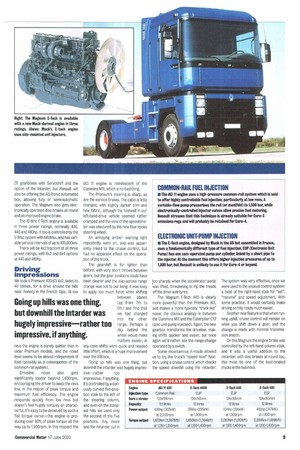Engine breaks with tradition
Page 10

Page 11

If you've noticed an error in this article please click here to report it so we can fix it.
The Premium 420dCi
The main changes to the Premium come in the new dCi 11 engine, which shares bore and stroke dimensions with the "old" 11-litre lump (still available at 340, 385 and 400hp) but is said to be an allnew engine, Four valves per cylinder, a reinforced block and articulated pistons are the main hardware changes, but the major innovation is common-rail injection; this is said to be its first appearance on a heavy-duty truck engine.
The dCi 11 is initially offered in Euro-2 form, and is said to give a 4-7% improvement in fuel economy compared with the existing 400hp engine, for an extra cost of about /2,500. Later this year a Euro-3 version will become available, with a slight deterioration in fuel consumption.
Other changes include the adoption of ZF's 16-speed gearbox. Renault has opted for a cable-operated shift mechanism, combined with the ZF Servoshift system—an air-operated shift assistance mechanism which reduces shift effort and shortens the throw between gears.
The ZF box also permits the fitting of 7F's Intarder, a hydraulic integral retarder which provides up to 500kW of braking power for a weight penalty of around 130kg. This is linked to a cruise control, built into the Mack-derived VMac III engine management system, to allow speed control up and down hills.
V-Mac is also linked to Renault's InfoMax fleet management system, which allows operators to download the truck's operating history. It also regulates service intervals, allowing up to 100,000km between changes of standard non-synthetic oil.
The Premium dCi 420 will first be offered as a 6x2 tractor, with a 4x2 version to follow.
The Magnum ETech
The latest Magnum comes with a raft of improvements. Like the Premium it gets
ZF gearboxes with Servoshift and the option of the Intarder, but Renault will also be offering the AS-Tronic automated box, allowing fully or semi-automatic operation. The Magnum also gets electronically operated disc brakes all round and an improved engine brake.
The 12-litre F-Tech engine is available in three power ratings, nominally 400, 440 and 480hp. It too is controlled by the V-Mac system with InfoMax, and has variable service intervals of up to100,000km.
There will be 4x2 tractors at all three power ratings, with 6x2 and 6x4 options at 440 and 480hp,
Driving impressions
We took a Premium 420dCi 4x2, laden to 40 tonnes, for a drive around the hills near Annecy in the French Alps, At low revs the engine is barely quieter than in older Premium models, and the noise level seems to be almost independent of load (possibly as a consequence of the common-rail system).
Driveline noise also gets significantly louder beyond 1,400rpm, encouraging the driver to keep the revs low, in the region of peak torque and maximum fuel efficiency. The engine responds quickly from low revs but doesn't feel hugely torquey or characterfulit's easy to be deceived by such a flat torque curve—the engine is producing over 80% of peak torque all the way up to 1,900rpm. In this respect the dCi 11 engine is reminiscent of the Cummins M11, which is no bad thing, The Premium's steering is sharp, as are the service brakes. The cabin is little changed, with slightly darker trim and new fabric, although the footwell in our left-hand-drive vehicle seemed rather cramped and the view of the speedometer was obscured by the new four-spoke steering wheel.
An annoying amber warning light repeatedly went on, and was apparently linked to the cruise control, but had no apparent effect on the operation of the truck.
The gearshift is far lighter than before, with very short throws between gears, but the gear positions could have been clearer and the slap-across range change was not to our liking: it was easy to apply too much force when shifting between planes (eg from 7th to 6th) and find that we had changed into the other range. Perhaps a day behind the wheel would make matters easier; in any case shifts were quick and needed little effort, which is a huge improvement over the 818 box.
Going up hills was one thing, but downhill the Intarder was hugely impres sive—rather too impressive, if anything. It's controlled by a curiously curved five-position stalk to the left of the steering column, and even on the steepest hills we used only the second of the five positions. Any more and the retarder out in too sharply when the accelerator pedal was lifted, threatening to rip the treads off the drive-axle tyres.
The Magnum E-Tech 440 is clearly more powerful than the Premium dCi, and makes a more typically "truck-like" noise; the obvious analogy is between the Cummins M11 and the Caterpillar C12 (also unit-pump injected). Again, the new gearbox transforms the driveline, making shifts quicker and easier, but once again we'd rather see the range-change operated by a switch.
Some mountainous A-roads allowed us to try the truck's "speed hold" function, using a cruise control which checks the speed downhill using the retarder. The system was very effective, once we were used to the unusual control system: a twist of the right-hand stalk for "set", 'resume and speed adjustment. With some practice, it would certainly make driving on hilly roads much easier.
Another nice feature is that when running uphill, cruise control will remain on while you shift down a gear, and the change is made with minimal transmission snatch.
On this Magnum the engine brake was controlled by the left-hand column stalk, and it was a useful addition to the retarder; with disc brakes all round too, this must be one of the best-braked trucks in the business.








































































































